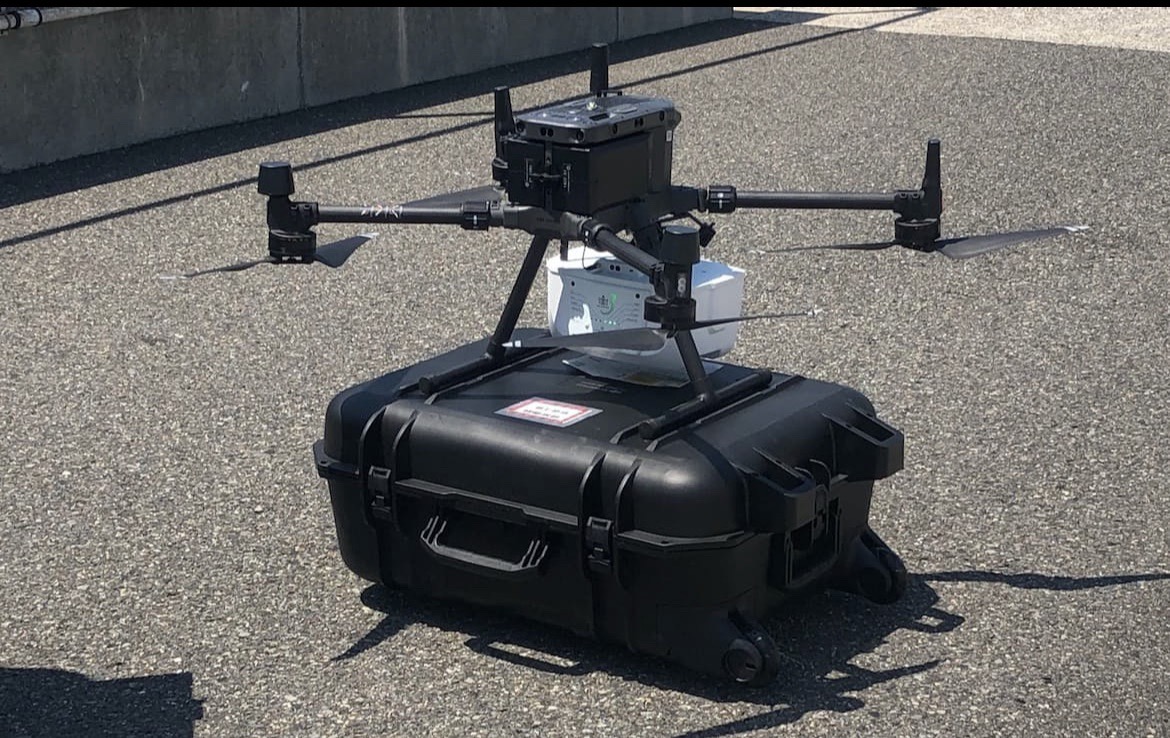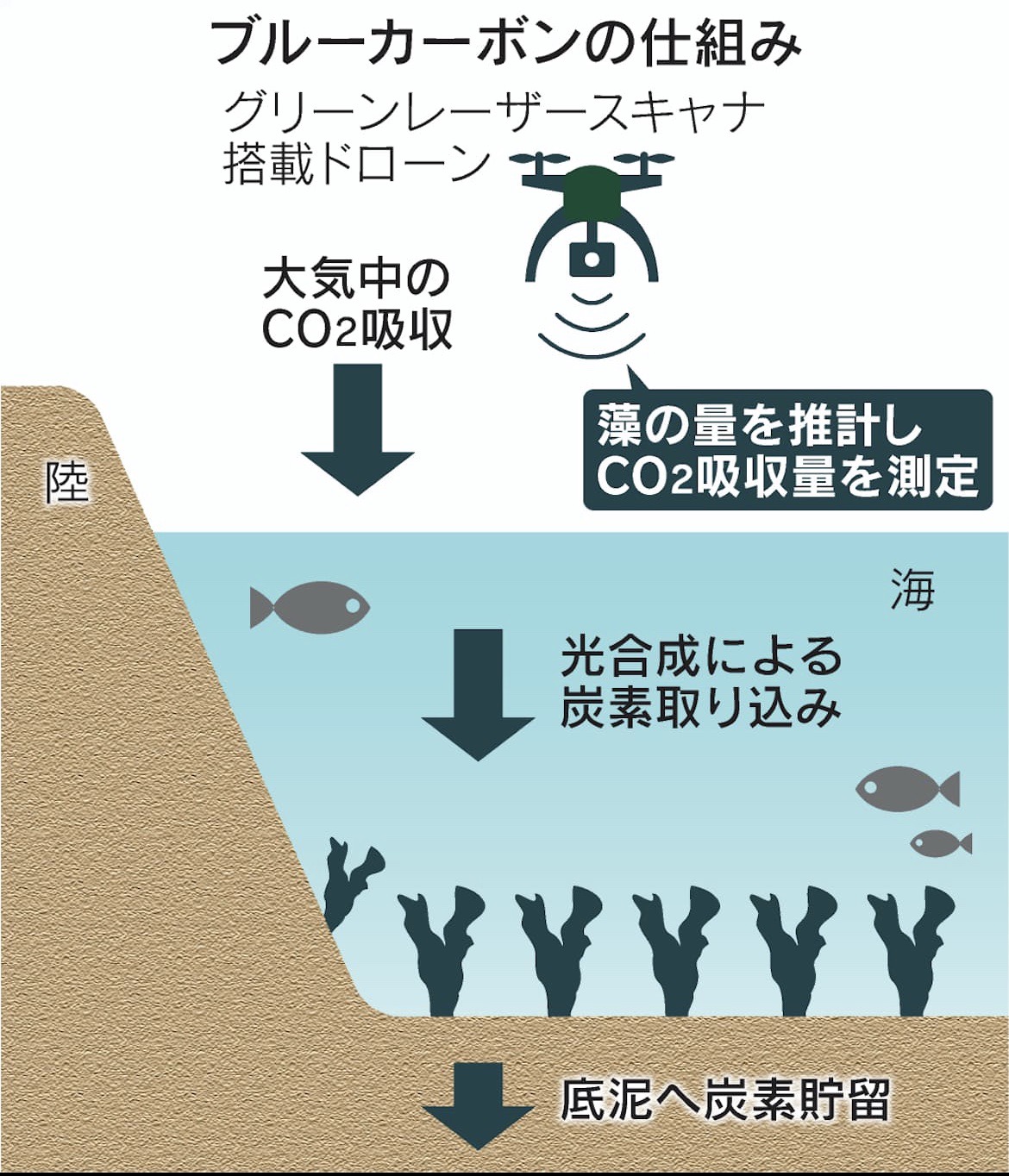Grow Blue Carbon Measuring algae with a laser such as J-Power
Technological development is progressing toward the expansion of "blue carbon," which is carbon dioxide (CO2) absorbed by algae in the sea. J-Power is working with the Port and Airport Research Institute (Yokosuka City, Kanagawa Prefecture) to conduct verification tests of surveying technology to determine the amount of algae. As a maritime superpower, Japan can easily secure places to grow seaweed beds, and there is a lot of room for expansion of blue carbon. If the development of technology that reduces the effort of operation progresses, it may become the centerpiece of decarbonization transactions in Japan.

A drone equipped with a green laser scanner actually flown at J-Power's algae cultivation base (Kitakyushu City)
Located on the coast of Kitakyushu City, J-Power's Wakamatsu General Office was once the company's first coal-fired power plant. ing. In May 2022, a drone with a wingspan of about 1 meter was seen roaring back and forth along the 1-kilometer embankment of the business site.
Surveying algae with a drone
Not just any drone. It is a drone equipped with a uniquely developed "green laser scanner" that uses a green laser that is not easily absorbed by water. "We got enough data." Takaharu Tomii, chief technology officer (CTO) of Amuse One Self (Osaka City), which developed the drone, nodded with Tomohiro Kuwae, head of the coastal environment research group at the Port and Airport Research Institute, who led the research.
Blue carbon is an initiative that focuses on the CO2 absorption capacity of the sea, including not only seaweed and algae beds, but also mangrove forests. Algae and other marine plants take in CO2 through photosynthesis, and part of it is stored on the seabed as mud for a long period of time. It is estimated that the amount of CO2 absorbed by shallow sea areas where algae grow is 4 billion tons per year, which is more than 50% of that for land areas such as forests.
The technology being tested this time is a technology for estimating the amount of algae in water based on drone surveys. To create blue carbon credits, it is necessary to ascertain the amount and type of algae in water as accurately as possible, and to measure the amount of CO2 absorption with high accuracy according to the amount of algae.
Currently, it is common to measure the surface area of seaweed beds from satellite data or photographic images taken by drones, but there is a risk that this method may not be able to identify algae that are difficult to see from the sky, such as seaweed growing on seawalls and seabeds. An underwater drone or a diver can actually go underwater and visually confirm the seaweed bed to accurately grasp it, but it takes time and it is difficult to record the exact position of the seaweed bed.
Amuse and others are developing a system for measuring the amount of algae that uses a green laser. First, a green laser is used to acquire the three-dimensional shape of the topography of the seabed and the positions and heights of objects such as algae in the sea. Using a unique algorithm, data such as solids in the water such as the water surface, seabed, and wave-dissipating blocks are removed from the three-dimensional shape obtained by the green laser, and the volume data of the algae is estimated, and only the shape data of the algae is extracted. do.

Kuwae, who is also the chairman of the Japan Blue Economy Technology Research Association (JBE), which promotes blue carbon credit certification, says, "The method of measuring the amount of algae itself is unique in the world."
Absorbs 100 tons of CO2 per year
The J-Power Wakamatsu General Office, which served as the demonstration site, has a track record of generating blue credits certified by JBE as the largest private company in Japan. Using wave-dissipating blocks mixed with coal ash and copper slag from the company's coal-fired power plant, a seaweed bed was created in the sea area of 6.4 hectares around the plant.
In order to obtain JBE certification, it is necessary to measure how much algae have grown as a result of the operator's management of the seaweed bed. J-Power has so far conducted visual observations such as diving by divers, but the company said, "It is necessary to improve the efficiency of measurement as we continue to expand seaweed beds." I decided to proceed.

Measuring the embankment of J-Power's office in Kitakyushu City (Kitakyushu City)
In fiscal 2010, the first year of certification, about 16 tons of blue credits were generated. According to J-Power, by expanding the seaweed bed to include other bases in the future, it is expected to absorb about 100 tons of CO2 per year. In Japan, JBE is working as a private organization to certify blue carbon credits, and three companies actually purchased credits in the 2020 certification.
European and American majors also enter
The number of companies participating in the certification system promoted by JBE is increasing rapidly, and interest is growing. In fiscal 2021, in addition to J-Power's Kitakyushu project, dozens of companies purchased credits equivalent to about 65 tons of CO2 absorbed by seaweed beds created in three locations in Japan, including the Port of Yokohama and Kobe.
The decarbonization trend is attracting international attention. Overseas, non-governmental organizations (NGOs) and major European and American companies are entering blue carbon one after another. Apple and Procter & Gamble (P&G) are investing in mangrove conservation. In the world, efforts are conspicuous mainly for mangroves, which are easier to measure than seaweed beds.
On the other hand, Japan is the world's sixth largest ocean power in terms of exclusive economic zone (EEZ) area, and there are many sea areas where seaweed beds grow easily, and the potential absorption of blue carbon by algae is large. It is said that Japan's coastal areas alone absorb more than 1 million tons per year. It is calculated to cover the annual CO2 emissions of about 350,000 households.
In terms of algae measurement technology, in addition to the green laser measurement method that Amuse and others are working on, various research and development are underway. The Sony Group is working with Hokkaido University to carry out demonstration experiments to measure the growth speed of seaweed and the area covered by seaweed using sensors submerged in the sea.






